Mastering the Craft of Homemade Bread Rolls

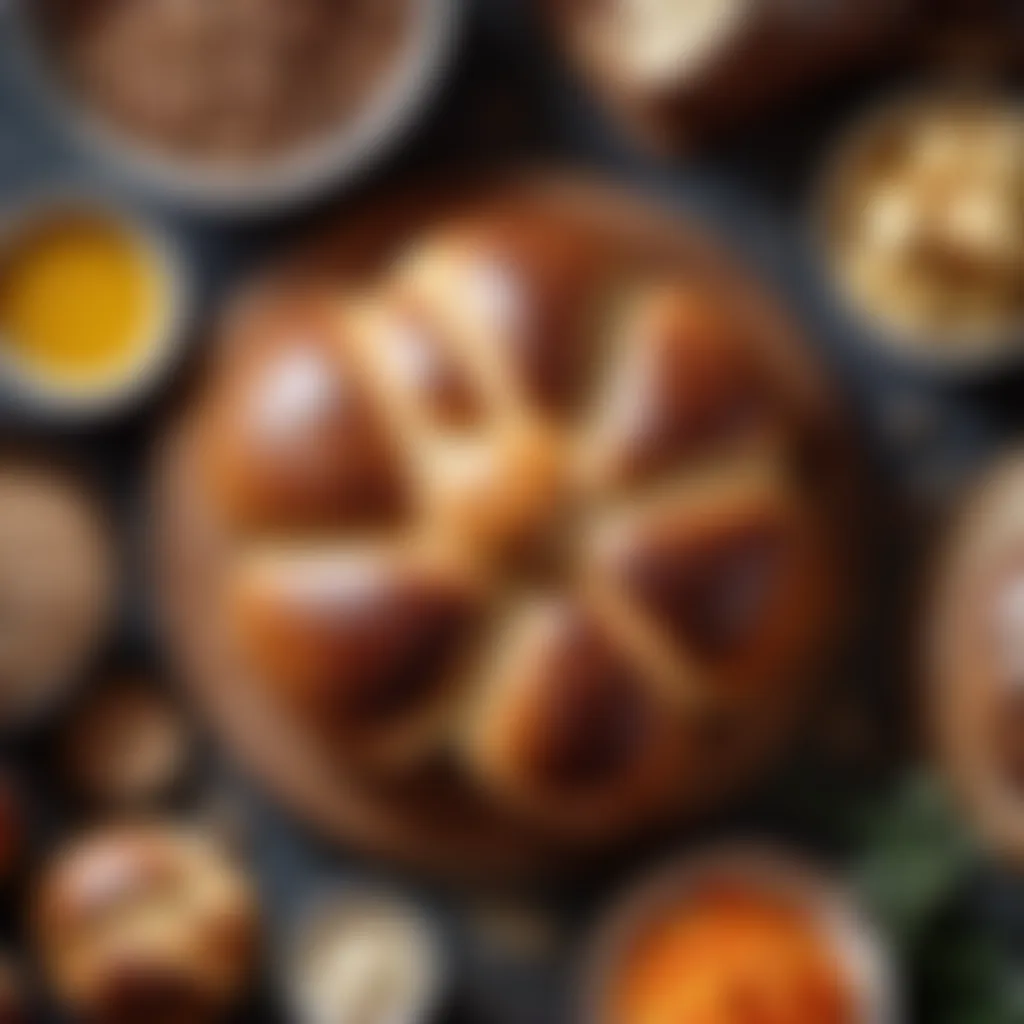
Intro
There's something about homemade bread rolls that evokes warmth and comfort, a marvel of culinary tradition that connects generations. The smell of freshly baked rolls permeates the air, promising satisfaction with each bite. Here, we embark on a journey to transform simple ingredients into delightful treasures.
Before diving in, it’s crucial to understand the essence of bread-making. It’s not just about mixing flour and water; it’s a dance of fermentation and transformation, where time plays a key role. So let’s roll up our sleeves and get down to business, starting with the most critical aspects: the ingredients and preparation.
Ingredients:
To create the perfect homemade bread rolls, the right ingredients are a must. Below is a list of what you’ll need:
- 4 cups all-purpose flour
- 1 packet (2 ¼ teaspoons) active dry yeast
- 1 teaspoon sugar
- 1 ½ teaspoons salt
- 1 ½ cups warm water (about 110°F or 43°C)
- 2 tablespoons unsalted butter (melted)
- 1 tablespoon vegetable oil
Note: Make sure all ingredients are fresh, especially the yeast, as this will greatly influence your roll's rise.
Preparation Steps:
Step 1: Activate the Yeast
Begin by activating the yeast. In a small bowl, combine the warm water, sugar, and yeast. Let it sit for about 5-10 minutes until it becomes frothy. This step signals that the yeast is alive.
Step 2: Mix Dry Ingredients
In a large mixing bowl, whisk together the flour and salt. This ensures even distribution of the salt, which can inhibit yeast growth if added directly with the yeast mixture.
Step 3: Combine Ingredients
Once the yeast is frothy, pour it into the flour mixture along with the melted butter and vegetable oil. Use a wooden spoon or your hands to combine until a shaggy dough forms.
Step 4: Knead the Dough
Turn the dough out onto a floured surface. Knead for about 8-10 minutes, until the dough is smooth and elastic. If you find the dough too sticky, sprinkle in a touch more flour.
Step 5: First Rise
Shape the kneaded dough into a ball and place it in a lightly oiled bowl, turning it to coat the surface. Cover it with a damp cloth or plastic wrap, and let it rise in a warm area until it doubles in size, about 1-2 hours.
Technical Aspects:
- Temperature Settings: Keep your kitchen warm (around 75-85°F or 24-30°C) to encourage yeast activity.
- Timing Specifics: Be patient; rushing the rise can lead to dense bread rolls. A visual cue is best: when the dough has doubled, it’s ready.
Cooking Process:
Step 1: Shape the Rolls
After the first rise, punch the dough down gently to release air. Divide it into 12 equal pieces and shape each into a ball. Place the rolls on a lined baking sheet, leaving enough space for expansion.
Step 2: Second Rise
Cover the shaped rolls with a cloth and let them rise again for about 30-45 minutes, until puffy.
Step 3: Preheat the Oven
While the rolls are rising, preheat your oven to 375°F (190°C). This ensures that they bake evenly and achieve a nice golden finish.
Step 4: Bake
Bake the rolls in the preheated oven for 15-20 minutes, or until they are golden brown on top. To check for doneness, tap the bottom; it should sound hollow.
Baking is both an art and a science; patience is vital.
Troubleshooting Tips:
- If the rolls do not rise sufficiently, your yeast might be old. Always check the expiry date.
- For rolls that are too dense, ensure you kneaded long enough and allowed adequate rising time.
- Overbaking can result in dry rolls. Keep a close eye towards the end of the baking time.
Understanding Bread Making Fundamentals
Understanding the essence of bread making is akin to grasping the very heart of culinary craftsmanship. When embarking on the journey of perfecting homemade bread rolls, knowing the fundamentals lays a solid foundation for every aspiring baker. This knowledge often forms the bridge between mediocre and outstanding rolls, and it emphasizes the intricate relationship between ingredients, techniques, and the science that guides the process.
The Role of Ingredients
Flour Types and Their Characteristics
Flour is often referred to as the backbone of bread-making, and for good reason. Different types of flour bring unique properties to the dough, influencing both texture and flavor. For instance, bread flour has a higher protein content than all-purpose flour, which means it develops more gluten and generally offers a chewier texture. This quality makes bread flour a go-to for many roll recipes.
However, it's important to consider that not every role requires this specific flour. Cake flour, with its lower protein content, results in softer, airier rolls, which might be delightful in certain recipes.
A humorous point some bakers might notice is the way whole wheat flour can absorb more water than white flour, affecting hydration levels. Balancing flour choice is key.
Understanding Yeast Functionality
Yeast is often thought of simply as a leavening agent, but its role is much more complex and fascinating. It ferments the sugars present in dough, releasing carbon dioxide gas and alcohol, ultimately causing the dough to rise. The key characteristic to note here is that yeast requires a warm environment and a little sugar to kickstart its activities. This makes it a fundamental ingredient in any successful baking endeavor.
Some bakers might lean towards instant yeast for its convenience, as it doesn't require proofing. However, active dry yeast can yield a richer flavor thanks to its longer fermentation time, though it demands a bit more patience from the baker. Both forms have their place in the kitchen, depending on your baking objectives.
The Importance of Hydration Levels
Hydration in bread making refers to the ratio of water to flour, and it's crucial for achieving the desired dough consistency. Higher hydration doughs can lead to oven spring and a more open crumb structure, resulting in delightful texture.
However, it can be tricky; too much water can result in a sticky, unmanageable dough. The unique feature of hydration is that it varies for different styles of rolls. For instance, a basic dinner roll might require about 60-65% hydration, while a soft, enriched roll could go as high as 70% or more.
Understanding this balance is vital—bakers often find hydration levels can make or break a recipe.
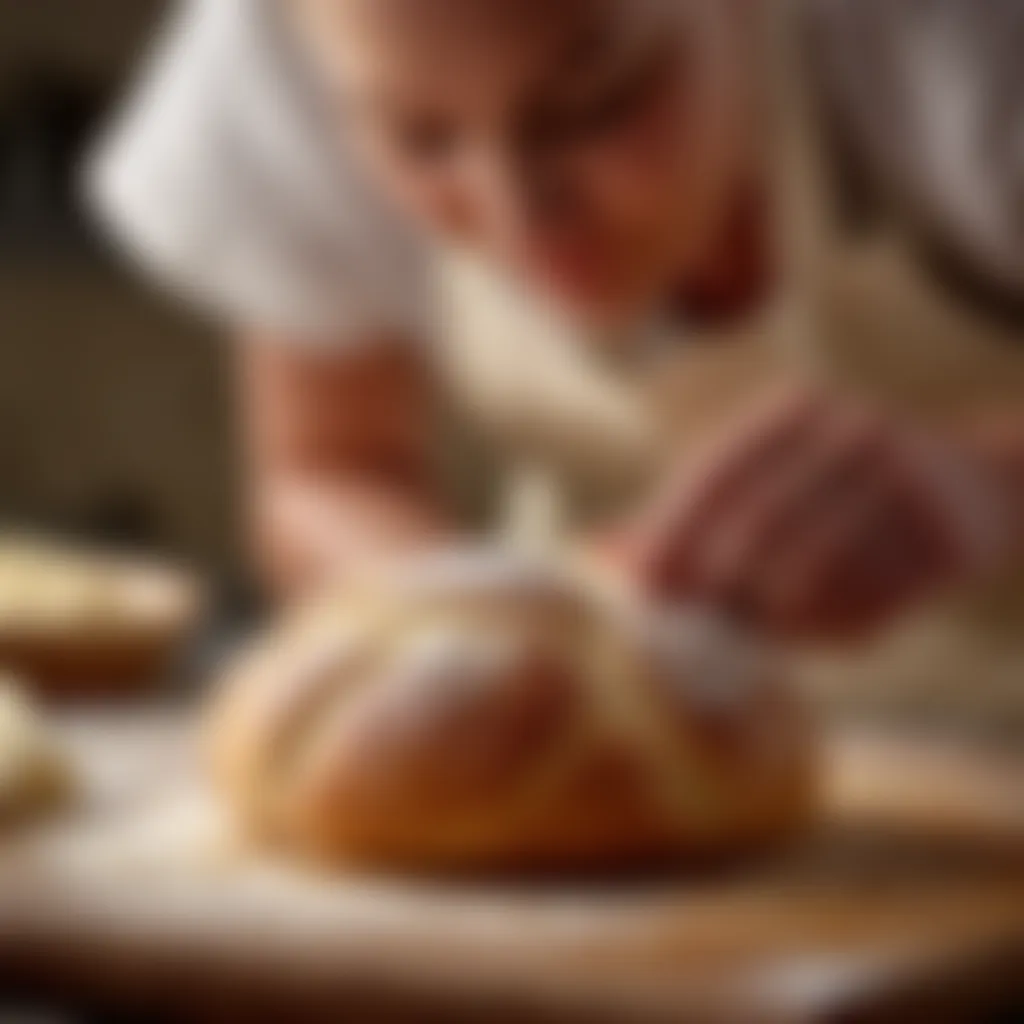
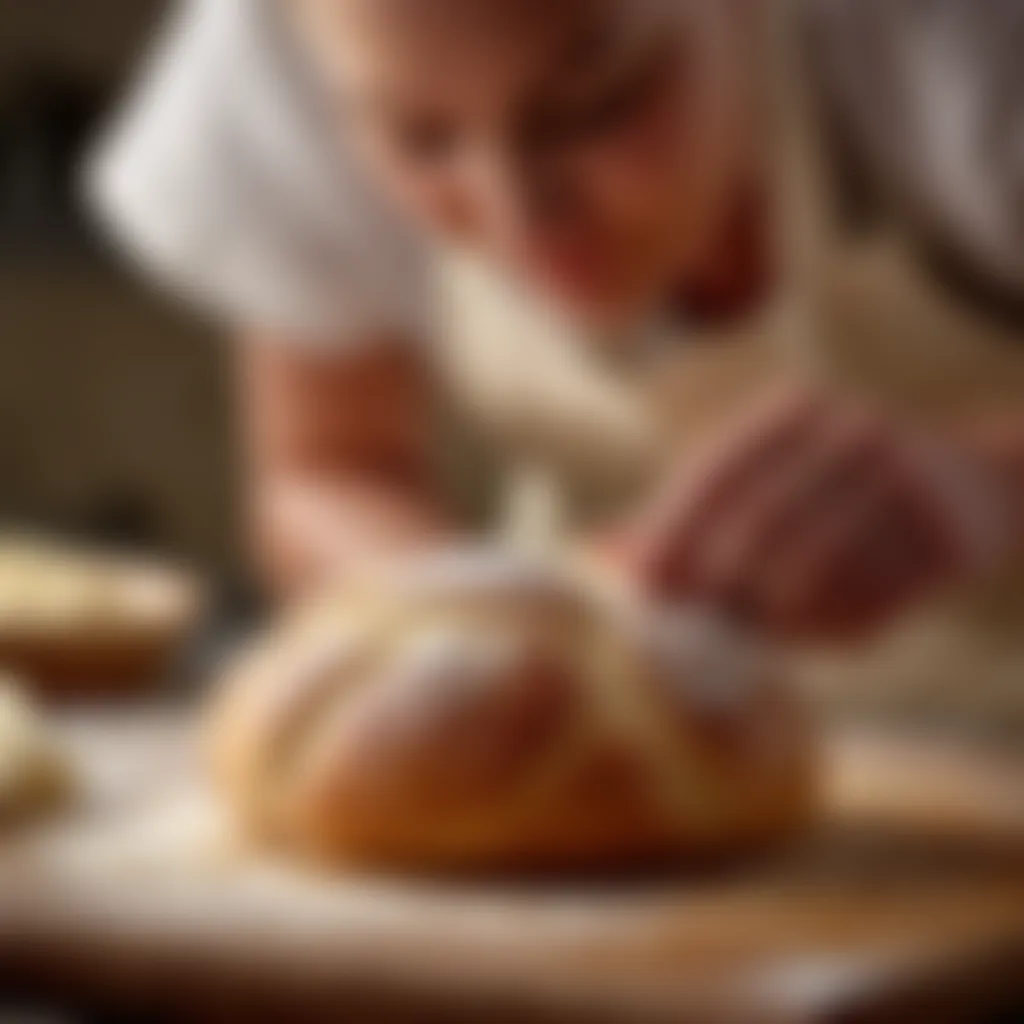
Utilizing Fats in Bread Rolls
Incorporating fats like butter or oil into bread rolls adds flavor, tenderness, and moisture. Fats interfere with gluten development, which is what creates that airy structure we’re all after. One key characteristic of using fats is that they create a softer and richer mouthfeel in the final product, beloved by many a family.
Interestingly, fats can also influence shelf-life. For instance, rolls made with oil often stay softer for a longer period than those made with butter. On that note, bakers can experiment with different types of fats to discover flavors—from classic unsalted butter to olive oil for a Mediterranean twist.
The Science of Fermentation
How Yeast Ferments Dough
The fermentation process is where the magic happens. Yeast, when mixed in the dough, feeds on the sugars and converts them into alcohol and carbon dioxide. This not only helps the dough rise but also develops flavor profiles over time. Understanding how yeast ferments dough is essential, as factors like sugar content and temperature can significantly impact the speed and effectiveness of this process.
It's common practice for bakers to monitor how long dough is left to ferment, given that each variety might demand different timing. This careful observation often translates to more nuanced and richer rolls, showcasing the depth of flavor.
Temperature and Its Impact
Temperature plays a pivotal role in the fermentation process. Colder environments tend to slow down the yeast activity, leading to longer fermentation times, which can in turn enhance the flavor. Conversely, warmer temperatures hasten fermentation but might risk overproofing, which deflates the dough and leaves it flat. The key here lies in developing a feel for the dough’s signs, allowing the baker to achieve that sweet spot of perfect fermentation.
Time Management in Fermentation
Properly managing time during fermentation affects the end result significantly. Allowing the dough enough time for fermentation means the development of complex flavors and textures. However, time can be a double-edged sword; overshooting the fermentation window can lead to overproofing, which is a common novice mistake. Observing dough volume and the signs of readiness is crucial in avoiding this pitfall.
In summary, comprehending the fundamentals of bread making—particularly the role of ingredients and the science of fermentation—equips aspiring bakers with essential knowledge that contributes to the success of homemade bread rolls. Once you hold these guidelines close, each batch of rolls becomes not just a chore, but rather an art form waiting for your creative touch.
Dough Preparation Techniques
Dough preparation is a crucial step in the journey of making homemade bread rolls. This stage not only sets the foundation for the textures and flavors but also shapes the entire outcome of your baking endeavor. The right techniques can significantly elevate your rolls from average to extraordinary. Mastering dough preparation means understanding distinct aspects such as mixing, kneading, shaping, and each of these plays an important role in developing your final product.
Mixing Methods
Hand Mixing vs. Machine Mixing
When it comes to mixing dough, bakers often face a dilemma between two approaches: hand mixing or using a machine. Hand mixing allows you to connect more intimately with the dough. Feeling its textures and consistency can help in judging when to stop adding ingredients. It's a tactile experience that's hard to replicate. However, machine mixing offers a level of efficiency that hand mixing just can’t touch. After all, that dough hook spins away tirelessly while you attend to other tasks.
One of the key characteristics of hand mixing is the visceral feedback from the dough. Each knead gives you an insight into hydration and gluten formation. On the other hand, machine mixing ensures a consistent mix and saves time and effort—an enticing offer for busy bakers. However, keep an eye on the dough! It’s quite easy to overwork it when using a machine, which might risk the gluten structure needed for light, airy rolls.
The Autolyse Method
The Autolyse Method is a brilliant technique that deserves attention in every baker's toolkit. This method entails mixing the flour and water first, letting them rest for a specified time before adding remaining ingredients like salt and yeast. This initial rest period enhances gluten development without the strenuous kneading that comes afterward. The key characteristic here is that it allows enzymes naturally present in the flour to start breaking down proteins and starches, yielding a more flavorful and smooth dough.
Bakers find the Autolyse Method beneficial because it simplifies the mixing and kneading process, delivering a dough that’s more extensible and easier to shape. The unique aspect of this method lies in its simplicity, which often results in a noticeably enhanced flavor profile of the rolls.
Windowpane Test for Gluten Development
One way to assess whether your dough has reached the right level of kneading is through the Windowpane Test. This involves stretching a small piece of dough to see if it forms a thin, translucent membrane without tearing. If successful, it signifies proper gluten development. The key characteristic of this test is its real-time feedback; you won’t have to guess whether your dough is ready. It’s one of the most straightforward ways to evaluate dough consistency.
This test is popular for a good reason: it provides a clear visual cue of your dough's readiness. It enables you to save time in the baking process, ensuring you don’t over-knead. While it isn’t foolproof for every type of dough—especially tender rolls—you'll find it invaluable in many baking situations.
Kneading and Shaping
Kneading Techniques Explained
Kneading is not just about working dough; it’s about developing wheat proteins into gluten, which is essential for the structure of your rolls. Various kneading techniques exist, from the classic push-fold-turn method to the slap-and-fold style. Each has its merits, but the key characteristic uniting them is the movement's creation of tension within the dough, an element crucial for achieving the right texture.
For many bakers, the method one uses can come down to personal preference. Some find the methodical rolling and folding approach calming, while others enjoy the more vigorous and rapid slap style. The unique aspect of kneading is its flexibility; regardless of your technique, each can produce excellent results with practice.
Types of Shaping for Rolls
Shaping rolls is more than just a final step; it’s where creativity and skill meet. There are numerous styles from simplistic round rolls to complex braided shapes. Each type of shaping adds its characteristic appeal and can impact the final texture and crust of the bread. For instance, a simple round shape allows for even baking but may lack visual interest. In contrast, a braided roll showcases craftsmanship and can even hold fillings.
Understanding these types fosters originality in your baking experience. No matter where your preferences lie, shaping bread rolls is an opportunity to showcase personal style.
Creating Uniformity in Shape
One of the goals in baking bread rolls is to create a uniform shape for even cooking and aesthetic appeal. The key characteristic of this practice is consistency, which is vital in professional settings but can also make home-baked bread rolls look appetizingly presentable. Using a scale can help; measuring each portion ensures similar sizes.
Achieving uniformity isn’t merely about looks, though. When rolls are identical in size, they’ll bake more evenly, preventing some from overbaking while others are still doughy. While it may seem like a small detail, it can elevate your bread rolls from homemade to bakery-quality.
Proofing: The Essential Stage
Few stages in bread-making are as vital as proofing. This process not only affects the texture and flavor of your bread rolls but also plays a significant role in how they rise. During proofing, the yeast consumes sugars, resulting in carbon dioxide gas that builds up and causes the dough to expand. This expansion is what transforms your raw dough into airy, fluffy rolls. Neglecting this step, or mishandling it, can result in rolls that are dense or lack flavor. Therefore, understanding proofing is essential for any aspiring baker.
Defining the Proofing Process
Optimal Proofing Environments
The concept of optimal proofing environments closely ties with achieving an excellent rise in your dough. A warm, humid place is often ideal for yeast activity. Think of a cozy corner of your kitchen, away from drafts or rapid temperature changes. This characteristic makes it easier for yeast to work its magic. A beneficial choice for the proofing process is a slightly warmed oven or a warm room. However, one should be cautious about excess heat; too much can kill the yeast, while too little can stall fermentation.
Unique Features: The balance between warmth and moisture makes these environments effective. An advantage includes a faster rise, while a disadvantage could stem from challenges in controlling temperature and humidity levels.
Identifying When to Stop Proofing
Knowing when to stop proofing can be a tricky business. Over-proofed dough becomes weak and can collapse when baked. A key characteristic of this phase is the dough's appearance; it should have roughly doubled in volume and have a slightly puffy texture. This understanding contributes significantly, as improper timing can lead to disappointing results.
Unique Features: The common method for assessing proof is the "poke test." If the dough springs back slowly, it’s ready. The advantage of this method lies in its simplicity; however, beginners may find it tricky to gauge correctly, leading to the risk of under or over-proofing.
A Common Misconception: Overproofing
Many bakers fear overproofing, often getting caught in the notion that it’s always detrimental. This misconception stems from a misunderstanding of dough behavior. Yes, overproofed dough can collapse; however, there are nuances to consider. A key aspect here is the timing; sometimes, dough can actually become more flavorful when fermented longer, just not to the point of collapse. It's crucial to develop a keen observation when managing proofing times.
Unique Features: The benefit of intentionally allowing for longer proofing under specific conditions can yield a richer flavor. A downside might be that without vigilance, you risk losing the right balance.
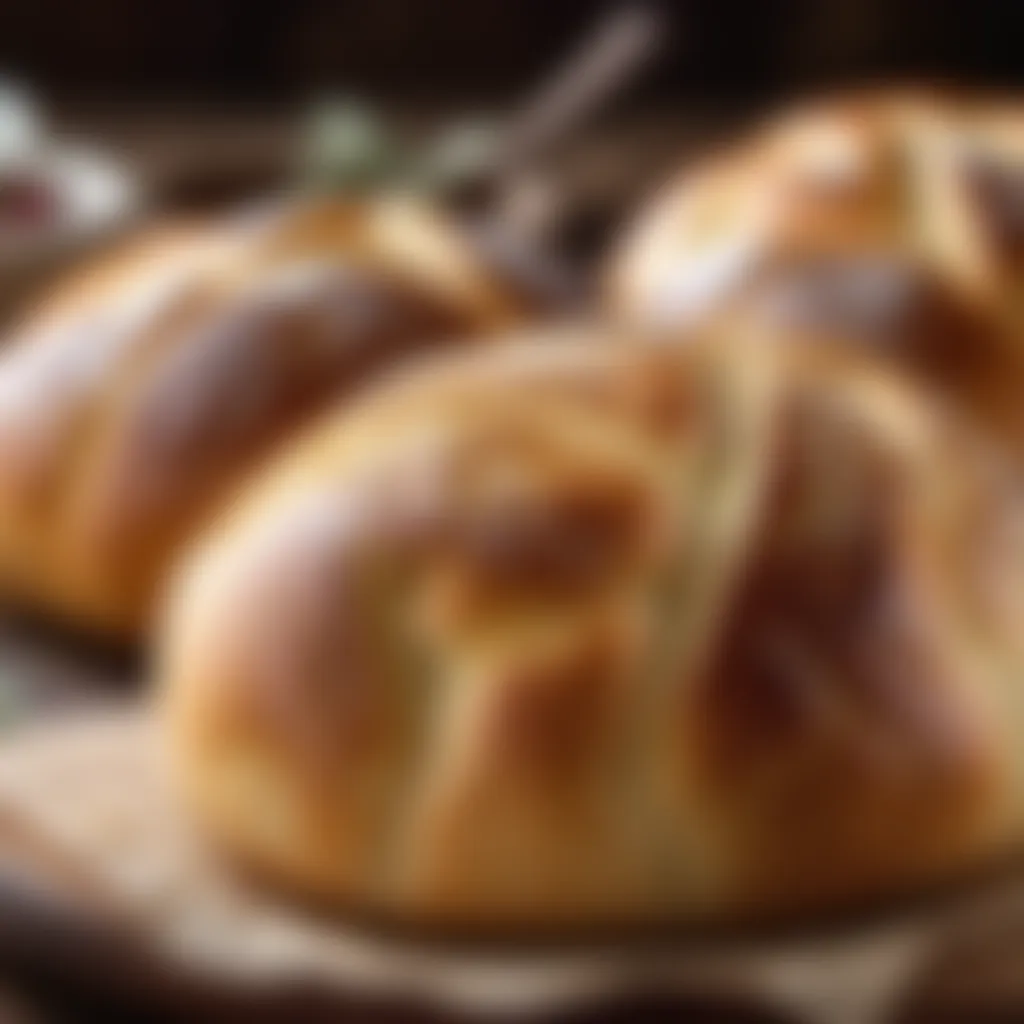
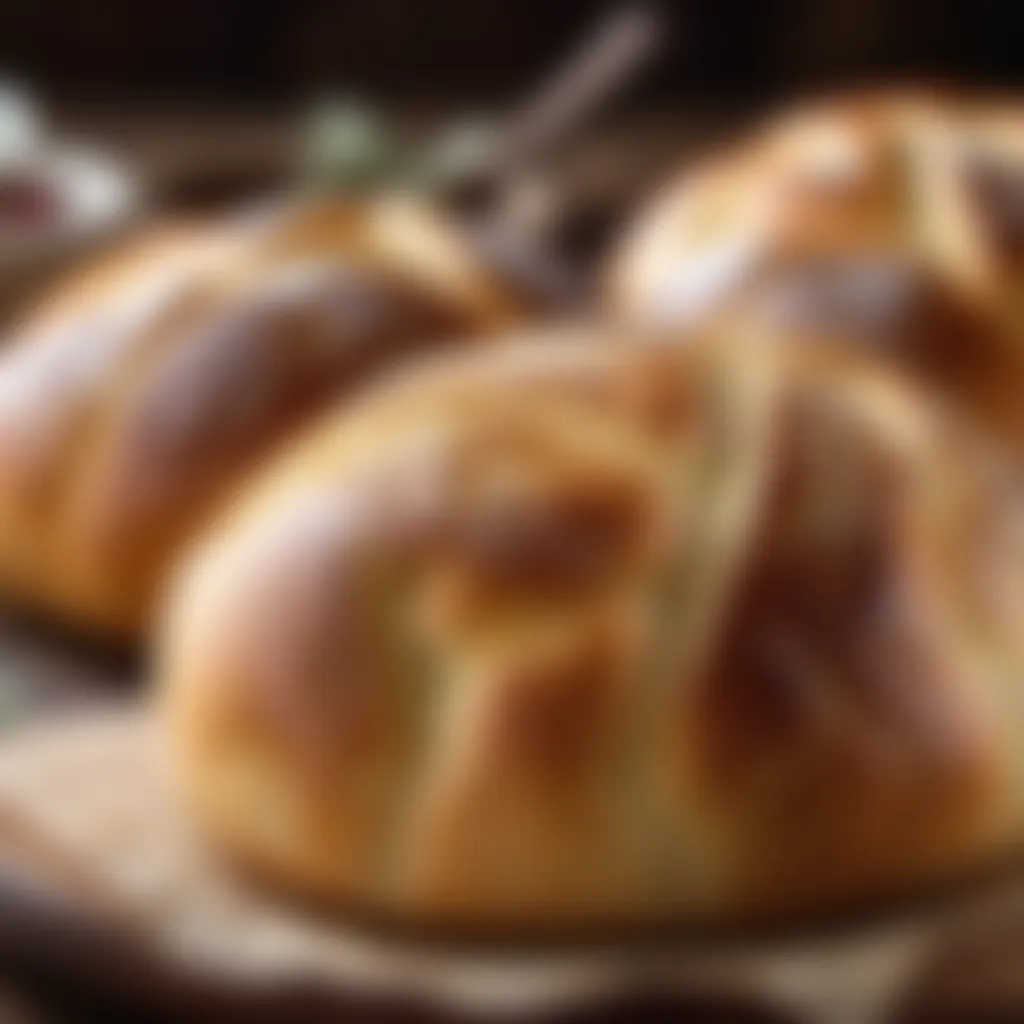
Factors Affecting Proofing
Humidity and Its Role
The impact of humidity cannot be underestimated when it comes to proofing. A humid environment not only aids yeast activity but also affects how the dough retains moisture. This is particularly helpful for rolls, as they require that perfect balance of moisture to maintain their texture. Higher humidity encourages a softer crust, making it a beneficial choice in many cases.
Unique Features: In environments with too little humidity, the dough may dry out, resulting in an undesired crust. Therefore, incorporating techniques like covering dough with a damp cloth can help achieve the right moisture balance.
Temperature Control Strategies
Temperature control strategies come into play in proofing, as temperatures that are too high can be more harmful than helpful. The ideal range for proofing typically lies between 75°F to 85°F (24°C to 29°C). A key characteristic of this strategy is maintaining a consistent temperature throughout the proofing period. This contributes to even fermentation, ensuring your rolls rise uniformly.
Unique Features: One might use a thermometer to check environments, but this can be cumbersome. Still, the advantage lies in perhaps reducing the inconsistency often seen in different kitchens when baked.
The Impact of Dough Types
Different types of dough respond uniquely to proofing. For example, enriched doughs, which contain fat and eggs, may require longer proofing times than lean doughs. A key characteristic is that the ingredients in dough directly influence the proofing process. This relationship plays a significant role in achieving desired flavors and textures.
Unique Features: Using the right approach for each dough type is critical. Lean doughs proof more quickly, while enrich doughs may take time. This blend of strategy helps create versatile rolls, but misreading can lead to issues as well.
Baking: The Final Touch
Baking is the climax of crafting homemade bread rolls, where all prior efforts coalesce into the final product. It’s not just about applying heat; it’s about making critical choices that influence the texture, flavor, and appearance of the rolls. This stage is often what separates mediocre rolls from exceptional ones. Understanding what happens in the oven, how to prepare correctly, and the nuances of various baking techniques leads to a gratifying reward—the perfect roll.
Pre-Baking Preparations
Before the dough enters the oven, the right preparations set the stage for success.
Choosing the Right Baking Vessel
The choice of baking vessel is crucial. A heavy-duty baking pan can significantly impact the way rolls cook. It conducts heat evenly, thus preventing hot spots that might scorch the bottoms while the tops remain pale. Metal pans, especially those made from aluminized steel, are often recommended because they heat up quickly, ensuring that the dough starts cooking as soon as it’s placed in the oven.
Key Characteristics: One key characteristic of a heavy metal pan is its ability to withstand higher temperatures without warping.
Unique Feature: The reflective surface often found in these pans means better browning. This can enhance the overall appearance of your rolls, making them golden and inviting. An important note, however, is that thinner pans might lead to uneven baking, leaving some parts undercooked while others could burn.
Activation of Steam for Crust Development
Steam plays a starring role in bread baking, especially for rolls that require a crusty exterior. The introduction of steam in the initial baking phase keeps the outer layer of the dough moist. This moisture allows for expansion, contributing to a light and airy structure while ensuring a crispy crust forms once the steam evaporates.
Key Characteristics: This technique is beneficial as it encourages the Maillard reaction, responsible for that beautiful brown color and complex flavor in baked goods.
Unique Feature: One practical method of generating steam is to add a pan of water to the oven or spritzing water directly onto the rolls before closing the oven door. However, a downside could be that if not done correctly, excess moisture may result in a soggy texture.
Baking Techniques
Many factors influence how your rolls come out of the oven, starting with how you operate the oven itself.
Understanding Oven Settings
Knowing your oven settings is imperative, as they can vary widely. Most home ovens have a simple dial or digital interface, but understanding convection vs. traditional settings can make or break your baking. In convection mode, a fan circulates hot air, reducing baking time and resulting in even baking.
Key Characteristics: Utilizing the convection setting might provide a crisper crust since the fan helps remove moisture more effectively.
Unique Feature: However, it's important to remember that this method might dry out softer doughs quicker than traditional methods, necessitating adjustments in both time and temperature.
The Role of Temperature Gradients
Temperature gradients in the oven affect the way rolls rise. When rolls are placed in a hot oven, the outer layers heat up while the inside layers still have time to remain cooler. This gradient creates a puffing effect during baking.
Key Characteristics: An even heat distribution allows for uniform growth in the rolls, leading to a more consistent final product.
Unique Feature: If temperatures are uneven, rolls might rise lopsided or worse—collapse—after being pulled out of the oven. Knowing how your specific oven operates and taking measures to correct any imbalances can vastly improve outcomes.
Baking Times and Their Variability
One of the most flexible aspects of baking is timing. Each oven has its quirks, meaning that baking times can vary from recipe to recipe. Roll size, dough density, and oven calibration are all factors.
Key Characteristics: Roll size is crucial; smaller rolls bake quicker than larger ones.
Unique Feature: Investing in a good instant-read thermometer can alleviate the uncertainty. Generally, bread rolls are done when they reach an internal temperature of about 190-205°F. But relying purely on time can lead to over or under-baking, contributing to poor texture and flavor.
Baking isn’t merely a process; it’s a blend of science and art. Understanding these facets not only boosts the quality of your bread rolls but also enriches your baking journey.
In summary, the baking stage is where theoretical knowledge meets practical application. By making careful observations and adjustments, you can ensure your bread rolls not only look great but taste delightful too.
Troubleshooting Common Issues
Baking bread rolls can feel like a walk in the park, but even the best home bakers can face hurdles along the way. Understanding how to troubleshoot common issues is essential for enhancing your skills and achieving that golden-brown perfection. When things don’t go as planned, knowing what went awry helps in correcting it, ensuring that you stick to this revered tradition of homemade bread rolls.
Addressing these problems allows you to refine your techniques and better enjoy the fruits of your labor. Ultimately, sorting out these challenges can elevate not just your baking game but also the flavors of the rolls you serve. Let's delve into the most common issues and how to tackle them head-on.
Examining Textural Problems
Textural problems are often the first signs something is amiss in your bread-making journey. Roll failures can range from being dense to crumbling at the slightest touch, and these inconsistencies often stem from a few key factors in your process.
Dense Rolls: Causes and Solutions
When faced with dense rolls, it’s crucial to pinpoint what went wrong. Dense rolls often result from inadequate gluten development or insufficient yeast activity. Poor kneading techniques can also play a role, leaving the dough tough and unfriendly to rise.
- Key Trait: Dense rolls can lack the airy lightness that many seek in their bread. They become heavy and sometimes unappealing, which can be disappointing.
- Common Reasons: If you fail to allow ample proofing time, or if you’ve used expired yeast, it’s likely that your rolls will end up dense.
- Remedies: Ensure that you knead the dough thoroughly, fostering gluten strength. Checking your yeast's freshness is another savvy move to prevent this.
- Bottom Line: Dense rolls might not be ideal for every occasion, yet understanding their root causes can help you create variety, offering a different texture when needed in a meal.
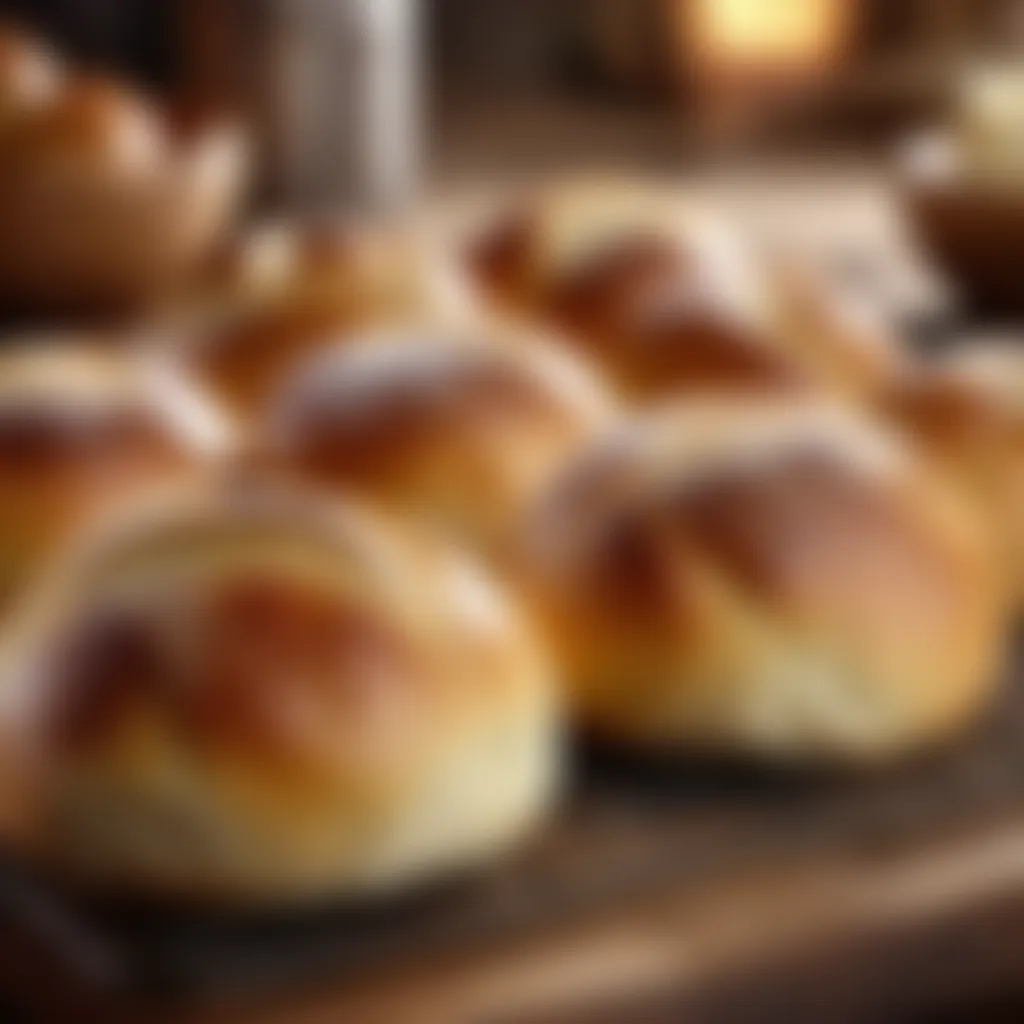

Too Crumbly: Understanding Ingredient Ratios
Crumbly bread rolls can deter enjoyment, presenting a challenge in the home baker's repertoire. This issue frequently stems from improper ingredient ratios, particularly the flour-to-water ratio. If there’s too little hydration or excessive fat, your rolls risk falling apart before they’ve hit the plate.
- Key Trait: The beauty of bread lies in its balance of ingredients, and when that balance tips, it can lead to dissatisfaction.
- Key Considerations: Using a greater volume of flour without sufficient water can lead to a dry, crumbly texture. Understanding this delicate balance becomes imperative for success.
- Solutions: Go back and measure your ingredients carefully and adjust accordingly to ensure a perfect mix—hydrating the dough enough while maintaining the integrity of the roll.
- Final Thought: While crumbly rolls may not be what you aim for, recognizing and adjusting your ratios effectively can turn things around. This insight sheds light on better baking practices overall.
Flavor Enhancements and Adjustments
To make your bread rolls memorable, enhancements can transform a simple recipe into a crowd-pleaser. Flavors should dance on the palate, making each bite worth savoring.
Incorporating Herbs and Spices
Herbs and spices can elevate ordinary rolls into something quite extraordinary. Integrating these components not only adds tantalizing flavors but also makes your rolls stand out at the table.
- Key Trait: Certain herbs, like rosemary or thyme, add freshness, while spices, such as garlic powder or paprika, bring depth.
- Example Adjustments: Consider infusing garlic into the dough or adding a dash of paprika for warmth.
- Benefits: The unique flavors create an artistic expression in your baking, appealing to the more adventurous eaters at your table.
- Word of Caution: However, moderation is key. Overdoing it can overwhelm the classic bread flavor that many cherish.
Balancing Sweetness and Saltiness
Creating a harmonious balance of sweetness and saltiness can be the backbone of flavorful bread rolls. This interplay enhances taste profiles and can elevate the dining experience.
- Key Trait: Bread rolls traditionally show a subtle sweetness, but it must be countered by salt to wake up the flavors.
- Pro Tip: Experimenting with different sugars—from honey to coconut sugar—can lead to delightful outcomes.
- Considerations: Paying heed to how salt interacts with yeast is vital; too much salt can inhibit rising.
- Bottom Line: A careful approach to balancing these tastes can unearth new depth, renewing your appreciation for homemade rolls.
Remember, each baking session is a lesson. Embrace the process, learn from each loaf, and enjoy the flavors that emerge!
Exploring Varieties of Bread Rolls
When it comes to homemade bread rolls, diving into the different types is akin to taking a culinary journey. Each variety carries its own flavor profile, texture, and regional significance. Understanding these variances not only broadens your baking repertoire but also allows you to introduce your friends and family to flavors they might not have experienced before. Plus, varying up the bread rolls can bring a fresh twist to your meals, making everyday dinners feel special.
Regional Variations and Styles
Classic Dinner Rolls
Classic dinner rolls often symbolize comfort and warmth. These soft, pillowy bites are commonly found at family gatherings and holiday feasts. The beauty of a classic dinner roll lies in its ability to serve as a canvas for various toppings, like butter or honey. What sets apart the classic roll is its mild flavor and buttery aroma, which makes it a highly liked choice at the dinner table.
The unique feature of classic dinner rolls is their light and airy structure, achieved through precise kneading and proofing techniques. They often rise beautifully in the oven, resulting in a golden crust that is just begging to be swept up with gravy or dipped in soup. The advantage here is their versatility; they can complement any meal, but there’s also a disadvantage: if not made properly, they can easily become dense and heavy.
Sourdough and Its Unique Characteristics
Sourdough bread rolls bring a distinct tangy flavor profile to the table. The fermentation process involved in making sourdough gives these rolls their unique bite and chewy texture. It serves a dual purpose in the bread-making process, as it not only enriches flavor but also improves digestibility, making sourdough a popular choice among health enthusiasts.
The key characteristic of sourdough is its reliance on natural yeasts found in the environment. This gives it a rich depth of flavor that is hard to replicate with commercial yeast. The unique feature of sourdough is the crisp crust that forms during baking, something many bakers aspire to achieve. One advantage of making sourdough rolls is the potential for longer shelf life due to the acidity, while a disadvantage can be the extended fermentation time, requiring more patience and planning.
French Bread Roll Techniques
French bread rolls, often seen in bistros and bakeries, boast an impressive crust and airy center. The French approach emphasizes precision in shaping and baking techniques. A key aspect is their use of a wet dough, which creates a beautiful crust through steam during the baking process.
The key characteristic of French bread rolls is their slender, elongated shape that also allows them to be filled with delicious ingredients, from savory to sweet. The unique feature is the crisp exterior juxtaposed with a fluffy interior—a delightful contrast. The advantage is in their presentation, making them suitable for various occasions, however, their often complicated preparation could pose a disadvantage for novice bakers.
Innovative Twists on Traditional Recipes
As bakers seek to push the boundaries of traditional recipes, fusion concepts emerge, marrying flavors and techniques from various cuisines.
Fusion Concepts in Bread Rolls
Fusion concepts in bread rolls can introduce unexpected ingredients and practices, leading to exciting new tastes. For example, think of rolls that mix traditional Italian focaccia with Asian-inspired spices and toppings. This inspires creativity, inviting you to experiment in the kitchen, leading to delightful discoveries.
The key characteristic of fusion bread rolls is their ability to surprise the palate. A uniquely flavored roll can elevate a simple meal to an extraordinary culinary experience. The advantage lies in the potential for endless innovation, while the disadvantage might be a risk of committing too much to experimentation without maintaining the core principles of bread-making.
Health-Conscious Alternatives
With the increasing demand for healthier eating options, health-conscious alternatives in bread rolls have become quite popular. By substituting refined flour with whole grains, seeds, or alternative flours like almond or chickpea, you create bread rolls that not only taste good but also pack a nutritional punch.
The key characteristic of these alternatives is their enhanced nutritional profile. They often come with added fibers and protein, addressing dietary concerns while satisfying cravings. One advantage is the growing acceptance of these healthier options, appealing to a wider audience. However, a potential disadvantage could be the challenge of achieving desirable texture and flavor synonymous with traditional rolls.
By exploring the vast varieties of bread rolls, bakers can significantly enhance their skills and the dining experience. Each type not only offers something different but also invites creativity and innovation into the kitchen.
Serving and Storing Your Bread Rolls
Serving and storing bread rolls properly is just as crucial as the baking process itself. If you have spent hours crafting the perfect batch of rolls, the last thing you want is for them to become stale or unappetizing shortly after baking. Understanding the nuances of serving and storing can enhance the experience for both the baker and the diners. When done right, this aspect will not only preserve the delightful qualities of your homemade rolls but also elevate the appeal of your meal.
Best Practices for Serving
Temperature Considerations
Temperature is key when it comes to serving bread rolls. Freshly baked rolls taste best when served warm, allowing their buttery flavors and soft textures to shine. Ideally, rolls should cool for about 10-15 minutes before serving. This allows for moisture to redistribute rather than escape, preserving that coveted soft interior. When rolls are served hot out of the oven, they can be too steamy, making it tricky to enjoy their true flavor and texture.
One characteristic of temperature considerations is that they drastically affect taste. Warm bread rolls are comforting, and they invite satisfaction, while cold ones may taste more like cardboard. While it is universally accepted that fresh bread should be enjoyed warm, it’s essential to avoid overdoing it—served too hot, they can burn mouths and completely ruin the dining experience. Thus, striking the right balance in serving temperatures is a beneficial tactic for any bread aficionado.
Condiments That Complement
Condiments can enhance your bread rolls in ways that may surprise you. Think beyond the basic butter. Flavored butters, jams, and even savory spreads can work wonders. A herb-infused butter could elevate a simple dinner roll, adding sophistication and an extra layer of flavor. Moreover, combinations like honey and butter can create a delightful sweetness that works well with many savory dishes.
A unique feature of condiments is their ability to personalize your meal. Home chefs often enjoy experimenting with various options, allowing for creativity at the table. However, it’s essential to choose accompaniments that balance with the flavors of the roll. For instance, a roll made with garlic might not go well with a grape jelly. Therefore, being thoughtful about the choice of condiments makes for a more enjoyable meal.
Storing Techniques for Longevity
Short-Term Storage Methods
Short-term storage methods help keep your rolls fresh without compromising their quality. The best way is to keep them in a bread box or on a kitchen counter, wrapped in a clean cloth or paper towel. This not only protects them from dust but also regulates moisture—keeping the rolls chewy instead of soggy.
A key characteristic of short-term storage is accessibility. Having your bread rolls at hand can make it easier for you or your family to grab a bite at any time. However, leaving them out too long can invite staleness. Keeping an eye on them is vital.
Long-Term Preservation Options
Long-term preservation methods, on the other hand, may involve freezing. For this, wrap the rolls individually in plastic wrap and place them in a freezer bag. This method can extend their viability for up to three months without significant quality loss. When you crave a homemade roll, you can pull them from the freezer, thaw them overnight in the fridge, and warm them in the oven for that freshly baked taste.
A notable benefit of long-term preservation is that it allows you to enjoy your hard work well beyond baking day. However, be sure to avoid freezer burn by ensuring they are wrapped snugly. It’s always good practice to label bags with dates to keep track of their freshness.
By keeping in mind the best practices for serving and effective storage methods, you can significantly enhance your overall bread-making experience, ensuring your homemade bread rolls are both delightful to serve and delectable to enjoy.







